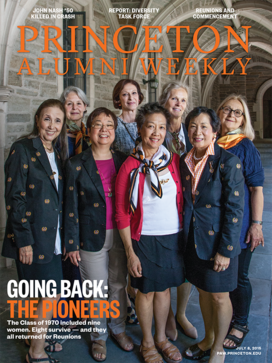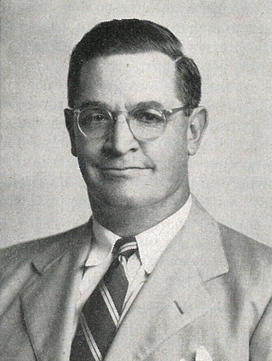Language is a virus from outer space.
— William S. Burroughs
As we celebrate what might be one of the last January exam stretches at Princeton, our clever editorial cabal once again has exerted its finest efforts to distract our dedicated alumni clientele with a lavish, multifaceted theme issue of Your Favorite Periodical, to amaze and amuse around the apres-ski fireplace and toddy(ies). I’ve sometimes mentioned that, as with most self-involved felines, all that’s really necessary to accomplish this with a Tiger is a ball of bright orange yarn, but the higher powers seem committed to the old consulting maxim, “underpromise, overdeliver,” the better to further please you finicky kitties out there.
Hence, my difficulty today. This year’s theme (whenever I say that, I have a flashback to the “Enchantment Under the Sea” dance in Back to the Future) is well-conceived, thus a real challenge to my specialized (i.e. pitifully narrow) academic expertise and/or ability to be cogent. In focusing on the topic of language, we have arrived both at a crucial issue in the vastly overcommunicatory world of the moment — perhaps most accurately and pathetically symbolized by the 140 characters of the Twitterati — and in any meaningful contribution I might make to the discussion, beyond that deft German standup-comedy routine I’ve been polishing since sophomore year. It killed ’em in Freiburg.
So, having discussed those limited options in my second language (with abject apologies to the legendary German professors Ted Ziolkowski and Stanley Corngold, who I’m certain do not wish to be connected with my academic efforts) and my third, Igpay Atinlay, in which I was not regarded as an “expert,” the editors suggested I focus on linguistic topics that virtually nobody else knew about, thus insuring I’d appear to have something worthwhile to contribute. “In the valley of the deaf…” as it were — and more about that later.
So let’s begin with one of my favorite language families, Critter. And sure enough, you say, you know Romance and Germanic and Dravidian, but you never heard of Critter? Bingo, I win. Like many other aspects of U.S. education, it got a kickstart in the aftermath of Sputnik with the National Defense Education Act (NDEA) of 1958, which among other ways to fight the Cold War came up with the insight that education in little-known foreign tongues could be a crucial weapon for the country, where only 15 percent of high schoolers were then taking foreign languages, virtually all those in French or Spanish. The languages deemed strategically necessary were termed “critical languages,” and ranged from Russian to Tamil to Arabic.
Now, Princeton had dabbled in modern language instruction even before the Civil War, and first James McCosh in 1868 and then Woodrow Wilson 1879 in 1905 had added heft to the field. By World War II East Asian studies and Near Eastern studies were renowned (not to mention Princeton in Asia), and by 1961 Slavic languages was thriving beside Romance and Germanic. So in line with the NDEA, Princeton by early 1963 constructed a one-year program that was funded by the Carnegie Corporation, offering its expertise in Arabic, Chinese, Japanese, Persian, Russian, and Turkish languages, and related regional studies in the social sciences and the humanities, to exchange students from around the East whose home colleges didn’t have them. And in a masterful illustration of our favorite Law of Unintended Consequences, some of the initial applicants were women. Since a smattering of women were already hard at work in the Graduate School via the logic that their programs of study were unique, the trustees were convinced by the parallel argument to allow five women to spend the 1963-64 school year in the critical language studies program, the first “Critters,” in undergrad parlance. Of course, the panic-stricken college only allowed them to live at the Seminary and they had to eat at the Wilson Society, since Prospect Street knew how to deal with “girls” as imports, but certainly not as Tuesday night fellow-diners.

While it’s not as photogenic as these Critter experts, I do have a soft spot for a truly obscure language, SNOBOL4. Never heard of it? Bingo again. In one of the first-rate non sequiturs of our time, I arrived at my intimacy with Bell Labs’ character-recognition computer programming language via Charlie Caldwell ’25, Princeton’s legendary football coach from 1945 until his untimely death in 1957. A maniacal organizer (just read his book), he had by 1949 polished his trademark single-wing offense until it obliterated most of those in its path — the next two years, Princeton went undefeated and won the Lambert Trophy, and Dick Kazmaier ’52 won the Heisman Trophy. Each Princeton offensive play had a four-character code, and every player on the field was graded for every play. Beginning in 1949, when IBM introduced its amazing new model 82 punch card sorter (650 cards processed per minute!), the state-of-the-art coach had this data entered onto computer punch cards along with field position, down and yardage to go, one card per play, and then had the cards sorted to give cumulative grades per player and results by play call, in a type of antediluvian Moneyball. Since he was succeeded as coach by his disciple Dick Colman, who used the same offensive system for another 13 years, by 1969 there was a pristine 20-year data set (in an era when most useful computer data was perhaps as old as five years) with consistent labeling of every football play Princeton had run; all comfortably contained on about 15,000 punch cards, weighing about 100 pounds.

One better-known language that I had never seen used at Princeton until October is American Sign Language (ASL); I’ll bet you haven’t either, so I’ll feign some expertise. There have been deaf Princeton students before — the Prince ran a feature on one, Jeff Mansfield ’08 — but all I know is I’ve never met one. At the recent Alumni Volunteers Conference, Colin Lualdi ’17, a physics major, deaf since birth, spoke (through an ASL interpreter) about all the efforts involving ASL at Princeton, virtually all begun by him: the ASL club, ASL tables at dinner, ASL credit classes in the curriculum. As the piece de resistance, he and two techie friends worked with support of Princeton’s eLab accelerator to create SignSchool.com, a website offering free lessons to help hearing people effectively learn ASL. When you examine all this and the various folks involved, you quickly realize that ASL offers its own syntax and thought process, its own logic and worldview: It is in fact as much a conceptual exercise as Mandarin or Afrikaans.

There is a reason that the First Amendment to the United States Constitution is first, and that has much to do with the immense power of language. There is also a reason that it nowhere includes the term “English.”










1 Response
Rich Seitz ’75
8 Years AgoAh, the issue has a theme...
Ah, the issue has a theme ... great one, and would wolfing and babe be taken as negatively as some of today’s slang? Having read the swimming article and every link in it, I would hope the discussion here would be better than that under the Columbia wrestling article.